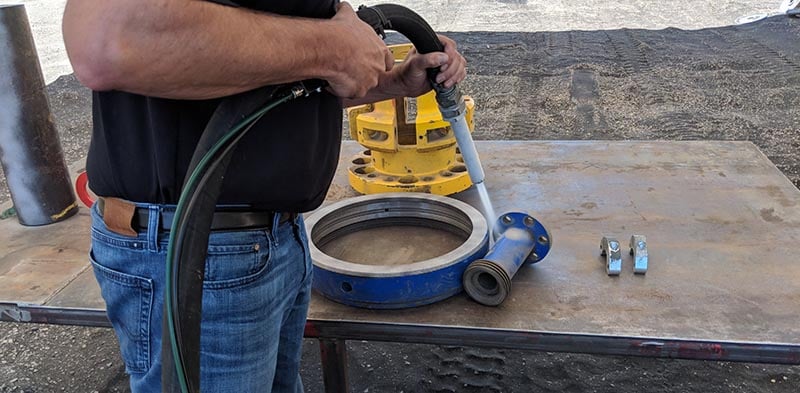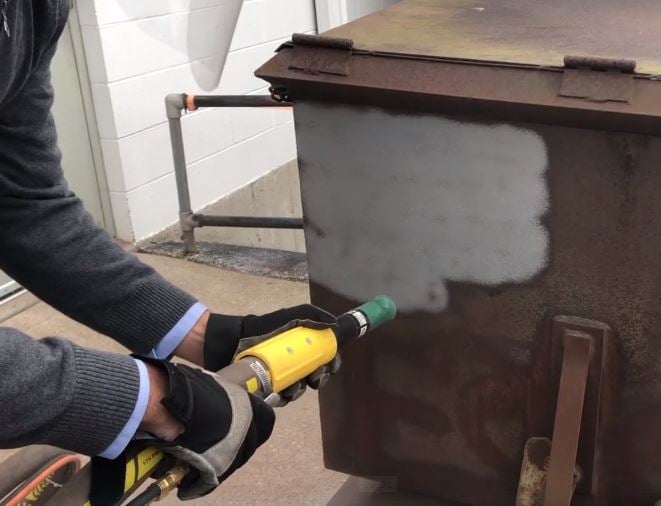Paint and coating stripping with dry ice blasting + abrasive
We often get asked the question, “Can dry ice blasting remove paint?” This can be a
tricky question as the answer is specific to the situation (type of paint, type of surface, how
Well, the paint adheres, etc.).
Dry ice is a gentle medium, and in some applications, it is not successful at removing
paint with just dry ice alone. Depending on the type of paint and primer, even aggressive
dry ice blasting can be too slow or too gentle.
Traditional methods for removing paint and other types of surface contaminants, such as
corrosion and paint are effective, but have negative side effects that can become
costly and add time to projects.
- Sandblasting and other types of media blasting create a significant amount of waste
and respirable and environmental dust. Not only does this require extensive
cleanup and containment setup, but it is also unhealthy for workers performing
the job. - These methods also leave residue and moisture on the surface being cleaned,
which requires a second wash and drying time before re-painting or re-coating can
begin.
Adding an abrasive to dry ice cleaning boosts its aggression and effectively removes
paint and coatings, while eliminating the issues with traditional methods of removal.
Why dry ice + an abrasive?
When you’re cleaning and preparing a surface, you want to be sure you can remove
100% of the surface contaminants and old paint/coating before applying a new coat –
and you want to do so as quickly and efficiently as possible.
Dry ice blasting + an abrasive has many benefits:
- Significantly reduces waste and dust generated by traditional methods
- Does not leave residual media on the surface being cleaned
- Does not require drying time (no water used in cleaning process)
- Provides a more environmentally sustainable and worker-safe cleaning method
.jpeg?width=900&name=Coating%20and%20corrosion%20removal%20(1).jpeg)
4 Benefits of dry ice + an abrasive
1) Dry ice + an abrasive eliminates pre- and post-cleaning processes
We are also commonly asked, “What are the disadvantages of sand blasting?” With the
need for containment setup and waste cleanup, methods such as sand, vapor, or slurry
blasting are time-consuming and labor-intensive. These methods create a tremendous
amount of secondary waste, which means containment must be set up before cleaning
begins, and when the cleaning ends, the secondary waste must be collected and
disposed of.
In the case of a stripping coating and corrosion from a tank with slurry blasting,
containment is set up for water runoff and other waste, which adds time and resources
to the project. When the stripping process is complete, workers must wait for the surface
to completely dry before applying a new coat.
Dry ice + an abrasive limits the amount of time and resources needed for a project by
eliminating the need for containment, waste cleanup, drying time, and any post-wash
steps. This leads to a considerable amount of hours saved per project.
Additionally, in saltwater environments, soluble solids and chloride accumulate on
surfaces, which results in an added pre-wash step that must first be removed before the
stripping even begins. Dry ice + an abrasive eliminates pre-washing because the media
removes soluble solids and chlorides simultaneously while stripping the paint from the
surface. With dry ice + abrasive, the cleaning can be completed in one step.
2) Dry ice + abrasive reduces dust levels and waste
As most people are aware, sandblasting and other traditional types of media blasting generate substantial dust and waste. Respirable dust is harmful to the operator, the surrounding workforce, the public, and the environment. OSHA has strengthened its standards to encourage initiatives that limit dust exposure. This is one of the reasons for the excessive containment setup required before cleaning with garnet, crushed glass, coal slag, and other blasting methods.
Wet blasting, such as slurry blasting and vapor blasting, uses water with an abrasive to capture dust molecules and keep them from going airborne. While this is effective at reducing dust levels, the method still creates a considerable amount of waste. As well, water as a medium slows down the abrasive particle velocity, which thereby limits productivity.
Dry ice blasting mixed with an abrasive seeks the best of both worlds. As the dry ice impacts the surface and sublimates from a solid to a gas, that gas suppresses the dust from going airborne because CO2 gas is heavier than air.
The reduced dust levels also leads to increased operator visibility, which makes it easier for the operator to clean effectively.
3) Dry ice + an abrasive is safer for employees and the environment – Meet OSHA guidelines

A 97% reduction in dust levels means that the operators and surrounding workforce are not exposed to unhealthy levels of respirable and nuisance dust. Dry ice + abrasive easily meets OSHA guidelines for dust levels.
Dry ice + abrasive is also a more environmentally friendly option compared to alternatives. The solution requires significantly less media input than alternative paint and corrosion stripping solutions.
The Cold Jet dry ice + abrasive solution uses 100-150 pounds of media per hour, as opposed to 600 pounds or more per hour from traditional options. This means that less media and dust are being dispersed into the surrounding environment.
4) Dry ice + an abrasive leads to extensive time and cost savings
The dry ice + abrasive mixture eliminates the need for pre- and post-washing, containment setup, and waste collection. It also cleans faster than many wet abrasive options. This results in a significant reduction in project time.
The solution also leaves the surface completely dry and free of residue, which eliminates hours of drying time and allows you to apply a new coat of paint or coating immediately following the cleaning process.

When should you use dry ice + abrasive?
1) Heavy or pitted corrosion
If the corrosion is pitted in the metal, dry ice alone won’t be enough to remove that corrosion for proper coating adhesion. With dry ice + abrasive, you can meet requirements for a surface standard before the new coating. It will give you a near white metal finish by removing a small layer of the metal and exposing a new metal surface profile.
This is a significant advancement for dry ice technology since dry ice blasting has always been non-profile, but by adding an abrasive, you can create a profile of 1-5 mL.
2) If dry ice blasting alone just isn’t working
Certain types of paint, corrosion, or coatings simply can’t be removed with the non-abrasive touch of dry ice alone. Depending on the many factors of the surface, dry ice + abrasive is usually best for industrial applications such as structural steel of ships, tanks, infrastructure, tanks and pipelines.
Cold Jet’s dry ice + abrasive solution: The E-CO2 150
The E-CO2 150 combines a Cold Jet dry ice blasting machine (PLT 60, Aero 80, or C100) with a custom 1.5 cubic feet pressurized abrasive pot. The system has been developed specifically to feed Cold Jet’s proprietary mix of dry ice and an abrasive medium. The custom blast pot enables users to experience accurate dosing of abrasive material, self-regulating capabilities, and integration of applicator control mechanisms to ensure that dry ice and abrasive feed are dispensed simultaneously when the trigger is pulled.
The proprietary solution has been 3rd party verified to reduce dust levels by up to 97%, thereby making it safer for the operator, the surrounding workforce, and the adjacent environment.
The E-CO2 150 also offers a stronger degree of versatility, allowing for non-destructive cleaning with just dry ice and also more aggressive cleaning with Cold Jet’s proprietary abrasive mix while remaining environmentally responsible. You can feel confident knowing that once you pull up to a job, you’ll be able to tackle it with the E-CO2 150.

A Powerful Dry Ice Blaster with an Abrasive
If your cleaning challenges demand serious power, you need the Aero2 PLT ULTRA dry
ice blaster + the E-CO2 150.
This system offers superior blasting pressure, reaching up to 250 PSI (17.2 bar) with a
feed rate of up to 6 lb/min (2.7 kg/min). This robust capability ensures you have more than
enough force to tackle even the most stubborn contaminants.

Cold Jet - The most reliable, durable, and advanced
dry ice blasting machines in the world
Whether your project calls for the unmatched power and versatility of dry ice blasting with
an abrasive, like the E-CO2 150 for aggressive paint and corrosion removal, or a gentler
yet, a highly effective solution like the Aero2 PLT ULTRA for non-abrasive cleaning, Cold Jet
offers a cutting-edge solution tailored to your needs.
By understanding the unique benefits of each approach, you can select the optimal dry ice
blasting system to achieve superior cleaning results, enhance safety, and significantly
reduce project time and costs.
Ready to begin dry ice blasting?
Check out this blog to see exactly what you need to get started!
.png) English
English